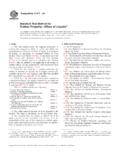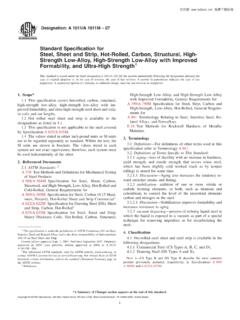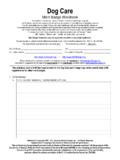Transcription of Standard Test Methods for Vulcanized Rubber and ...
1 Designation: D 412 06a 2 Standard Test Methods forVulcanized Rubber and Thermoplastic Elastomers Tension1 This Standard is issued under the fixed designation D 412; the number immediately following the designation indicates the year oforiginal adoption or, in the case of revision, the year of last revision. A number in parentheses indicates the year of last reapproval. Asuperscript epsilon ( ) indicates an editorial change since the last revision or Standard has been approved for use by agencies of the Department of Defense. 1 NOTE Added research report footnote to Section19editorially in October 2008. 2 NOTE Revised Eq 9 editorially in December These test Methods cover procedures used to evaluatethe tensile (tension) properties of Vulcanized thermoset rubbersand thermoplastic elastomers.
2 These Methods are not appli-cable to ebonite and similar hard, low elongation Methods appear as follows:Test Method A Dumbbell and Straight Section SpecimensTest Method B Cut Ring SpecimensNOTE1 These two different Methods do not produce identical The values stated in either SI or non-SI units shall beregarded separately as normative for this Standard . The valuesin each system may not be exact equivalents; therefore eachsystem must be used independently, without combining Standard does not purport to address all of thesafety concerns, if any, associated with its use. It is theresponsibility of the user of this Standard to establish appro-priate safety and health practices and determine the applica-bility of regulatory limitations prior to Referenced Standards:2D 1349 Practice for Rubber Standard Temperatures forTestingD 1566 Terminology Relating to RubberD 3182 Practice for Rubber Materials, Equipment, andProcedures for Mixing Standard Compounds and Prepar-ing Standard Vulcanized SheetsD 3183 Practice for Rubber Preparation of Product Piecesfor Test Purposes from ProductsD 3767 Practice for Rubber Measurement of DimensionsD 4483 Practice for Evaluating Precision for Test MethodStandards in the Rubber and Carbon Black ManufacturingIndustriesE4 Practices for Force Verification of Testing Adjunct.
3 Cut Ring Specimens, Method B (D 412) Standards:ISO 37 Rubber , Vulcanized and Thermoplastic Determina-tion of Tensile Stress-Strain Properties43. set the extension remaining after a specimenhas been stretched and allowed to retract in a specified manner,expressed as a percentage of the original length. (D 1566) set-after-break the tensile set measured byfitting the two broken dumbbell pieces together at the point strength the maximum tensile stress appliedin stretching a specimen to rupture. (D 1566) stress a stress applied to stretch a test piece(specimen). (D 1566) stress at-given-elongation the stress requiredto stretch the uniform cross section of a test specimen to agiven elongation. (D 1566) elastomers a diverse family of Rubber -like materials that unlike conventional Vulcanized rubbers canbe processed and recycled like thermoplastic elongation the elongation at which ruptureoccurs in the application of continued tensile point that point on the stress-strain curve, shortof ultimate failure, where the rate of stress with respect tostrain, goes through a zero value and may become negative.
4 (D 1566)1 These test Methods are under the jurisdiction of ASTM Committee D11 onRubber and are the direct responsibility of Subcommittee on edition approved Dec. 15, 2006. Published January 2007. Originallyapproved in 1935. Last previous edition approved in 2006 as D 412 referenced ASTM standards, visit the ASTM website, , orcontact ASTM Customer Service at ForAnnual Book of ASTMS tandardsvolume information, refer to the Standard s Document Summary page onthe ASTM drawings are available from ASTM Headquarters, 100 Barr HarborDrive, Conshohocken, PA 19428. Order Adjunct No. from American National Standards Institute (ANSI), 25 W. 43rd St.,4th Floor, New York, NY ASTM International, 100 Barr Harbor Drive, PO Box C700, West Conshohocken, PA 19428-2959, United by ASTM Int'l (all rights reserved); Mon Feb 9 22:30:39 EST 2009 Downloaded/printed by3M Co pursuant to License Agreement.
5 No further reproductions strain the level of strain at the yield point.(D 1566) stress the level of stress at the yield point.(D 1566)4. Summary of Test The determination of tensile properties starts with testpieces taken from the sample material and includes thepreparation of the specimens and the testing of the may be in the shape of dumbbells, rings or straightpieces of uniform cross-sectional Measurements for tensile stress, tensile stress at a givenelongation, tensile strength, yield point, and ultimate elonga-tion are made on specimens that have not been stress, yield point, and tensile strength are based on theoriginal cross-sectional area of a uniform cross-section of Measurement of tensile set is made after a previouslyunstressed specimen has been extended and allowed to retractby a prescribed procedure.
6 Measurement of set after break isalso Significance and All materials and products covered by these test meth-ods must withstand tensile forces for adequate performance incertain applications. These test Methods allow for the measure-ment of such tensile properties. However, tensile propertiesalone may not directly relate to the total end use performanceof the product because of the wide range of potential perfor-mance requirements in actual Tensile properties depend both on the material and theconditions of test (extension rate, temperature, humidity, speci-men geometry, pretest conditioning, etc.); therefore materialsshould be compared only when tested under the same Temperature and rate of extension may have substantialeffects on tensile properties and therefore should be effects will vary depending on the type of material Tensile set represents residual deformation which ispartly permanent and partly recoverable after stretching andretraction.
7 For this reason, the periods of extension andrecovery (and other conditions of test) must be controlled toobtain comparable Machine Tension tests shall be made on apower driven machine equipped to produce a uniform rate ofgrip separation of 500650 mm/min (2062 ) for adistance of at least 750 mm (30 in.) (seeNote 2). The testingmachine shall have both a suitable dynamometer and anindicating or recording system for measuring the applied forcewithin62 %. If the capacity range cannot be changed for a test(as in the case of pendulum dynamometers) the applied force atbreak shall be measured within62 % of the full scale value,and the smallest tensile force measured shall be accurate towithin 10 %. If the dynamometer is of the compensating typefor measuring tensile stress directly, means shall be provided toadjust for the cross-sectional area of the specimen.
8 Theresponse of the recorder shall be sufficiently rapid that theapplied force is measured with the requisite accuracy duringthe extension of the specimen to rupture. If the testing machineis not equipped with a recorder, a device shall be provided thatindicates, after rupture, the maximum force applied duringextension. Testing machine systems shall be capable of mea-suring elongation of the test specimen in minimum incrementsof 10 %.NOTE2 A rate of elongation of 10006100 mm/min (4064 )may be used and notation of the speed made in the report. In case ofdispute, the test shall be repeated and the rate of elongation shall be at 500650 mm/min (2062 ). Chamber for Elevated and Low Temperatures Thetest chamber shall conform with the following Air shall be circulated through the chamber at avelocity of 1 to 2 m/s ( to ft/s) at the location of the gripsor spindles and specimens maintained within 2 C ( F) of thespecified A calibrated sensing device shall be located near thegrips or spindles for measuring the actual The chamber shall be vented to an exhaust system orto the outside atmosphere to remove fumes liberated at Provisions shall be made for suspending specimensvertically near the grips or spindles for conditioning prior totest.
9 The specimens shall not touch each other or the sides ofthe chamber except for momentary contact when agitated bythe circulating Fast acting grips suitable for manipulation at high orlow temperatures may be provided to permit placing dumbbellsor straight specimens in the grips in the shortest time possibleto minimize any change in temperature of the The dynamometer shall be suitable for use at thetemperature of test or it shall be thermally insulated from Provision shall be made for measuring the elongationof specimens in the chamber. If a scale is used to measure theextension between the bench-marks, the scale shall be locatedparallel and close to the grip path during specimen extensionand shall be controlled from outside the Micrometer The dial micrometer shall conform tothe requirements of PracticeD 3767(Method A).
10 For ringspecimens, these test for Tensile Set Test The testing machinedescribed an apparatus similar to that shown inFig. 1may be used. A stop watch or other suitable timing devicemeasuring in minute intervals for at least 30 min, shall beprovided. A scale or other device shall be provided formeasuring tensile set to within 1 %.7. Selection of Test Consider the following information in making selec- Since anisotropy or grain directionality due to flowintroduced during processing and preparation may have aninfluence on tensile properties, dumbbell or straight specimensshould be cut so the lengthwise direction of the specimen isD 412 06a 22 Copyright by ASTM Int'l (all rights reserved); Mon Feb 9 22:30:39 EST 2009 Downloaded/printed by3M Co pursuant to License Agreement.



